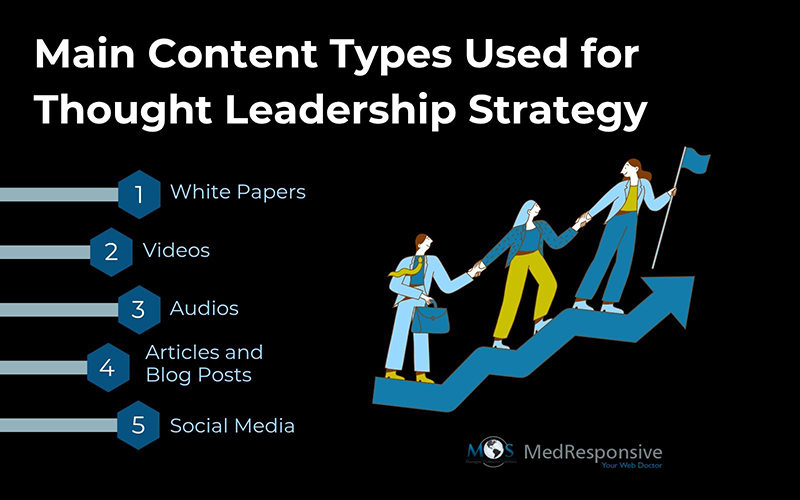Every year, Forbes unveils its annual “30 under 30” innovative list, which highlights 30 influential young leaders in various industries such as tech, entertainment, and finance. This list, which showcases rising stars that are shaping the future of their respective industries, is anticipated by millions across the world. It is one of the notable examples of thought leadership content, celebrating innovation, leadership, and vision in a way that resonates deeply with both industry professionals and the public. Since companies may not always have access to fresh expertise and industry perspectives within their internal teams, collaborating with providers outsourcing digital marketing services is an ideal option.
What Is Thought Leadership Content and How Can Brands Initiate It?
Thought leadership content refers to authentic, innovative, and reliable pieces of material published by an individual, businesses, or professionals in their chosen niche. It differs from average SEO-optimized content, which focuses primarily on keyword rankings and search engine visibility. Thought leadership pieces are designed to share new insights, inform the audience, and establish a brand or individual as an authoritative voice in a specific domain.
The intent of thought leadership content is not necessarily to convert leads or drive sales, although these can be indirect benefits. The core purpose is to position the brand, organization, or individual as a thought leader within their industry, someone whose insights are valued and trusted by others.
A common misconception in the business realm is that authoritative content is created simply to capitalize on trending topics or generate revenue. While it does provide significant marketing benefits, this is not the primary goal. What expert opinion pieces do is educate the audience on certain topics, develop solutions to specific problems, or provide a fresh, unique perspective on issues—often controversial ones—that are relevant to the industry.
To incorporate thought innovation into your digital marketing efforts, adopt a holistic, sustained strategy by focusing on given objectives:
- Establish Vision and Goals: Business owners and industry experts must plan and develop the key objectives or goals behind investing in thought leadership strategy. This strategy is particularly beneficial for organizations aiming to enhance credibility, establish authority, drive industry influence, and boost brand recognition. Establishing these goals from the outset will help to shape and measure your campaign efforts.
- Audience Alignment: The success of thought leadership content hinges on how well it aligns with the needs, interests, and pain points of your audience. Understanding your target audience, what challenges they face, what solutions they seek, and what type of content they value will enable you to craft messages that resonate. This involves listening to your audience, observing industry trends, and identifying opportunities to fill knowledge gaps with fresh perspectives.
- Consistency and Engagement: Thought leadership isn’t just about publishing content—it’s about actively participating and shaping the direction of industrial conversations. Industry experts must engage with other thought leaders, share their unique insights on trending topics, and respond to current events or innovations. This requires ongoing commitment and a steady stream of high-quality content that is visionary, well researched, and reflects the brand values of your company. By consistently demonstrating your personal expertise on the evolving industry landscape, business owners can transform themselves into industry leaders.
- Leverage Various Content Types: Effective thought pieces aren’t limited to just one type of content, there’s a whole gamut of content formats that you can publish. In fact, the best thought leaders produce a diverse mix of content to reach different audience segments and adapt to varying consumption preferences. For example, while one segment of your audience might prefer in-depth articles or whitepapers, others may be more engaged with short-form social media posts or podcasts.
- Measure and Adapt: Finally, measuring the success of your thought leadership content is essential to gauge the effectiveness of your content marketing efforts. Companies shouldn’t just push out materials—they must also listen, discover, and adapt strategies based on feedback. Through tools like Google Analytics or social media insights, you can monitor key performance metrics (KPIs) and understand which types of content resonate most with your audience and refine your strategy over time. This helps to create a dynamic content strategy that evolves based on data and shifting industry trends.
Key Content Types for Thought Leadership Strategy
Thought leaders can present their content to audiences in various formats, each with its unique strength. Depending on the type of business, intended audience, and overall marketing goals, companies can choose content types that resonate, reflect their brand ethos, and drive real-world impact. Here are a few examples:
- White Papers and Reports
White papers and industrial reports allow industry leaders to share authoritative, well-researched documents that provide in-depth analysis on a specific issue. They are perfect for demonstrating your expertise in a detailed and structured way. Research reports are particularly impactful when they reveal new trends, benchmarks, or annual performance metrics within an industry. This type of content appeals to those who are looking for concrete, data-driven insights to inform their decisions. For example, a tech company can explore the impact of artificial intelligence on software development with data-backed insights and best practices. It helps to position your business as a thought leader and can be used to generate leads by delivering the white paper in exchange for contact information.
- Videos
Video content has proven to be highly engaging and accessible, allowing businesses to connect with audiences on a personal level. By using video, businesses can showcase products, explain complex ideas, or tell compelling stories. Videos bring your content to life, allowing you to demonstrate practical applications of your services or products in a relatable way. For example, a healthcare tech company could produce a video showing how their innovative health monitoring tool works in real-life scenarios and aids in enhancing patient care. This can foster stronger emotional connections with your audience and boost brand loyalty.
- Audios
Audio content types such as podcasts are ideal platforms for leaders to discuss industry trends, share expert opinions, and conduct interviews with industry peers or experts. As they are shared in episode formats, scheduling a content calendar is beneficial to keep users engaged for a longer period. With the ability to listen while engaging in other activities such as commuting, podcasts provide an on-the-go content format that resonates with the audience on a deeper level. A marketing agency, for instance, could host a podcast discussing the latest strategies for social media marketing, featuring expert guests and actionable takeaways for listeners.
- Articles and Blog Posts
Articles and blog posts remain one of the preferred forms of content for businesses to present well-researched content, delve into important topics, and provide useful advice to their audience. Blog posts are excellent for improving SEO and attracting organic traffic. This content type is highly versatile, as content creators can incorporate interactive elements, infographics, or industry reports to make it more engaging and personalized. For example, a financial advisor could share quick tips or calculators that help individuals assess their financial management, providing immediate value to the participants.
- Social Media
Content strategists can utilize social media platforms to actively interact and share their unique takes with the audience through comments, forums, and posts. By directly communicating with users on social media, leaders can create regular touch points with their users, nurturing a strong network of supporters and online community. For instance, a mobile app development company can encourage users to submit stories or testimonials, adding a touch of human element and social proof to their brand. Industry experts can also collaborate with influencers or authority figures in their niche to foster meaningful conversations and expand brand visibility. This can open new avenues for business leaders to boost industry influence, making it a valuable part of a comprehensive thought leadership strategy.
Build Exceptional Thought Leadership Strategy with Outsourcing
Businesses can start on their path towards exceptional thought leadership strategy by partnering with affordable digital marketing partner. Outsourcing allows you to tap into the knowledge of experienced marketers and strategists who understand the intricacies of creating high-quality thought leadership content. Instead of relying solely on the internal team’s time and resources, this approach helps companies to produce high-quality, tailored content that speaks directly to their audience’s needs. Whether it’s tapping into industry experts for unique insights, or collaborating with data analysts for impactful reports, outsourcing gives the flexibility and scalability to focus on core business goals. With the right partner, you can amplify your brand’s authority, expand your reach, and ultimately become a recognized leader in your field.





